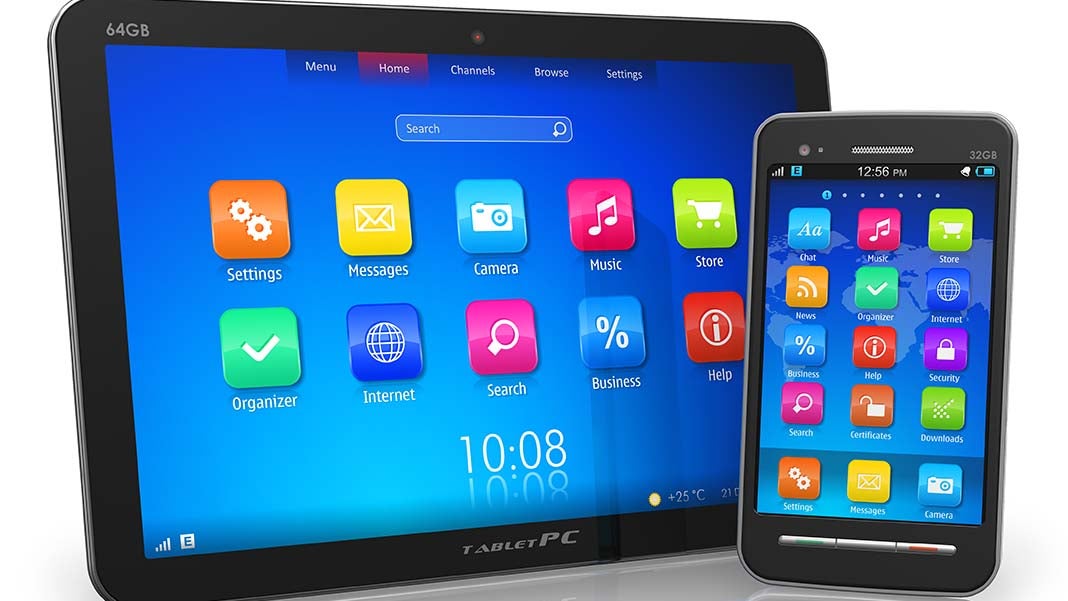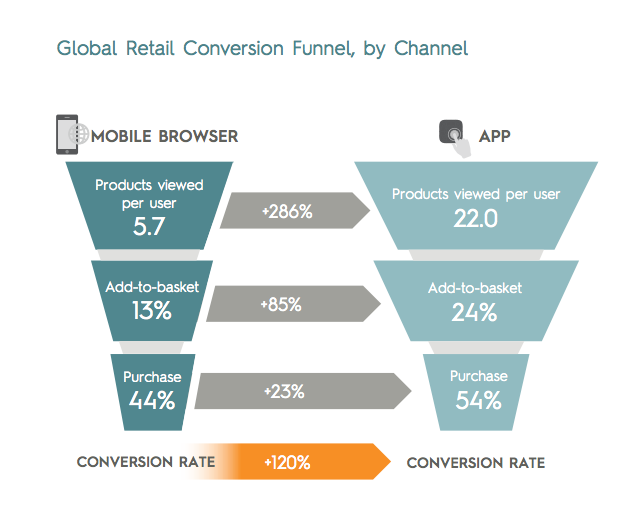Hey Retailers: Want to Boost Sales Conversion? Build a Mobile App
By: Chris Horton

Perhaps the best piece of evidence that a given marketing technology has reached maturity and broad-based consumer acceptance lies in its ability to drive conversion actions at every stage of the buying cycle. According to Criteo’s Q4 2015 State of Mobile Commerce report, mobile apps are doing just that, at least for U.S. retailers. By providing online shoppers more detailed and relevant product information and a clear path to the purchase, mobile apps are trumping mobile web browsers and even desktops to become the preferred method of online—and specifically mobile—commerce.
For my money, here are the two chief takeaways of the report: 1) for leading retailers, mobile is becoming the dominant force in a fast growing eCommerce ecosystem, and 2) dedicated shopping apps are outperforming the mobile web at every conversion point, from initial product browsing to the final sale.
But how did we get there?
eCommerce is on the Rise
The story begins with the steady rise of eCommerce within a sprawling U.S. retail landscape. Newly released retail data from the US Commerce Department shows that online sales accounted for more than half of total retail sales growth in 2015. And that’s not the half of it. Once you factor out items not normally bought online, like fuel and automobiles, e-commerce accounted for essentially all retail sales growth in 2015. Here are some relevant nuggets from the Commerce data:
- Online sales totaled $341.7 billion in 2015, a 14.6% increase over 2014’s $298.3 billion; this as total retail sales grew just 1.4% year-over-year.
- Q4 web sales reached $89.08 billion, up 14.7% from $77.66 billion a year earlier.
- Online sales accounted for 7.3% of total retail sales in 2015 versus 6.4% in 2014, and e-commerce accounted for 66.4% of total retail sales growth.
It’s worth noting that, at $341 billion, eCommerce still represents a relatively small portion (7.3%) of total US. retail sales ($4.69 trillion). However, with eCommerce responsible for fully two-thirds of all retail gains in 2015, the trend is unmistakable: eCommerce is has become the growth engine of retail.
mCommerce is Driving eCommerce
If eCommerce is the future of retail, it looks like it will be driven by mCommerce. According to 2015 holiday season data from Hooklogic, mobile commerce accounted for over 50% of all eCommerce site traffic. The shift to mCommerce is likely to continue apace in coming years, propelled by higher levels of global smartphone penetration. This view is supported by a recent eMarketer/Tune global mobile study, which predicts that by 2020, 80% of the world’s population, or roughly 6.5 billion people, will own a smartphone.
Mobile Apps are Dominating mCommerce
The findings of the Criteo report underscore a third emerging reality for retailers, namely that eCommerce growth is increasingly driven by mobile commerce, and the most effective mCommerce tool for retailers is the mobile app. Commenting on the report in an article for Marketing Land, Greg Sterling offered this apt summary:
“Perhaps the most interesting finding in the report is that retailers with successful apps are driving higher volumes of mobile commerce than the average. While apps constituted a bare majority (54 percent) of mobile transactions by volume, app-based mobile shoppers are much more engaged and much more likely to convert than mobile web users. According to the report, app-conversion rates were 120 percent higher than mobile browser conversions and higher than desktop conversions, as well.”
When it comes to successful mobile apps, the Criteo report draws a clear connection between customer experience, engagement, and conversion.
Retail apps that place a central focus on the customer experience—i.e. that are able to provide shoppers relevant and useful products and a clear path to the purchase—tend to enjoy higher levels of customer engagement and higher rates of conversion than either mobile web or desktop. Moreover, newer technologies like deep linking and mobile retargeting can help retailers drive sustained engagement and transactions to their apps.
Indeed, higher mobile app adoption rates will create (are already creating) a greater demand for app-centric SEO techniques like app indexing and deep linking as we move inexorably to a mobile-app dominated search ecosystem. Those interested in reading more about in-app SEO should check out this in-depth piece I wrote on the subject.
The Criteo report also found that, when compared head to head with mobile browsers, apps dominate every stage of the sales funnel. Specifically, app users browse almost four times more products than mobile web users and are almost two times more likely to add items to their basket in an app than in a mobile browser.
Source: State of Mobile Commerce Report Q4 2015
Finally, it’s worth noting that mobile apps also bring in more revenue per transaction than either mobile browsers or desktops, although the differences are relatively small (Mobile Apps=$102; Desktop=$100; Browser=$92).
The Future of Mobile Commerce
In summary, the findings of the Criteo report suggest that mCommerce will to continue to drive eCommerce moving forward. Mobile transaction share is already nearing parity with desktop, and this trend is expected to continue apace as leading retailers build customer-friendly mobile websites and transaction-driving apps. Mobile apps in particular are fast becoming an essential retail transaction channel that will continue to improve as best practices to boost conversion rates and average order values are adopted throughout the industry.
All very neat and tidy, but is the future of eCommerce and, by extension, mCommerce, really all about mobile apps? Are the days of the mobile browser numbered?
Like so many things in life, I believe the answer lies somewhere in between, as leading retailers move to take advantage of a host of new technologies—from deep linking to app indexing in leading search engines like Google—to provide consumers seamless, intuitive, and contextually relevant shopping experiences as a means of easing the path to the purchase and increasing customer retention. In time, I think we will see a de facto merging—or convergence, if you will—of mobile apps and the mobile web, at least from the perspective of the end user.
Writing in a company blog post, TUNE CEO Peter Hamilton does a good job of summarizing this notion:
“In 2016 we’ll see streamlined web experiences that ease the path to purchase first, and then deepen the experience in an app. The web helps avoid app store barriers, and apps help by retaining customers. As each continues to evolve they take on more qualities of the other until the difference is nearly indistinguishable.”
I’d say that’s about right. Even so, if you’re a retailer willing to take the Criteo findings at face value, it’s difficult to deny the conversion power of mobile apps.













